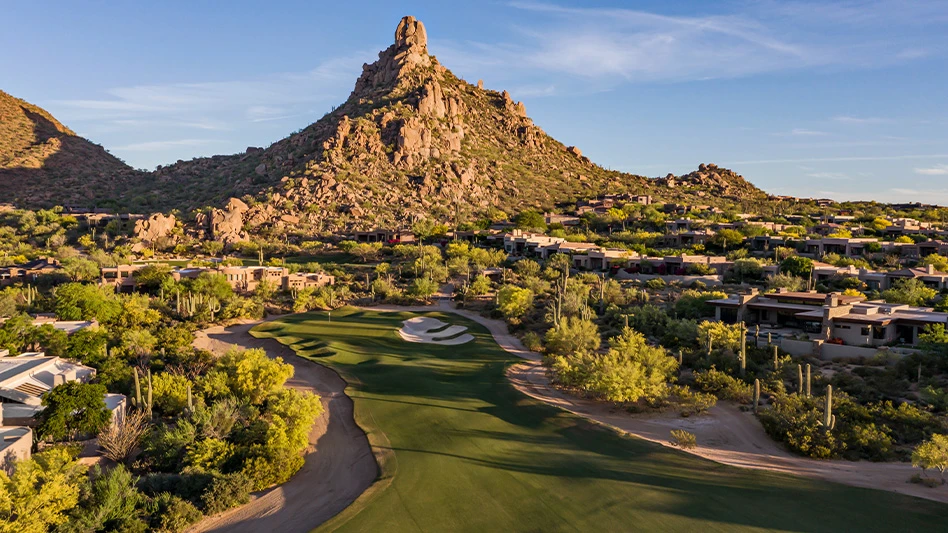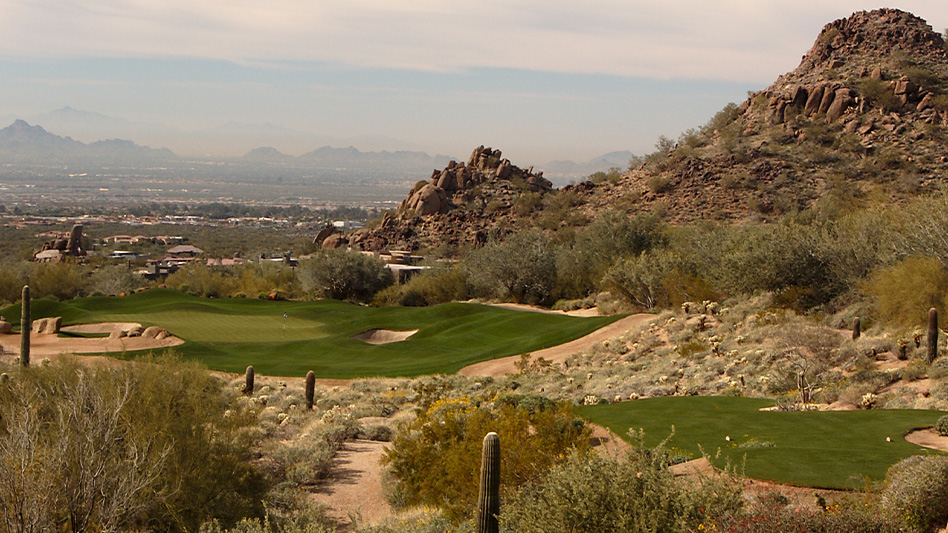
Courtesy of Desert Highlands (2)
Desert Highlands, the original home of The Skins Game will embark on an extensive renovation project to its Jack Nicklaus Signature Golf Course in the Sonoran Desert of North Scottsdale.
Spearheaded by Nicklaus Design, the renovation project will include six major components: design enhancements to several holes, greens reconstruction, tee reconstruction, bunker reconstruction, desert de- and re-vegetation, and restoration of the turf found on the tees, fairways and rough.
Jack Nicklaus visited Desert Highlands in July 2021 to offer his insight on the renovation and design enhancements, a rare occurrence for the Golden Bear these days. The $10 million golf course renovation project is set to begin in April 2025 and should be completed by November 2025.
“The plans Nicklaus Design has for Desert Highlands are nothing short of compelling,” general manager Desi Speh said. “This renovation project will not only further solidify Desert Highlands as one of the state’s most sought-after golf experiences, but also enhance the aesthetic appeal of our community.
“We have every degree of confidence Nicklaus Design will return our golf course to its purest form, while maintaining the quality and status that has been a standard bearer in the North Scottsdale area for over 40 years.”
A major aspect of the renovation will be the design enhancements occurring on several holes of the golf course:
- A new forward tee box on No. 5 will allow players an easier opportunity to cross the wash in front of the putting surface in two shots.
- Nicklaus advised changing the eighth green complex to better see the putting surface from the landing area. The green will be rotated more perpendicular to the line of play and sloped more from back to front to open the views. The mounding will be brought closer to the right and back of the green to allow some shots to bounce onto the putting surface.
- New tee boxes will be created on the 10th hole to move players away from the back of the range and to accommodate possible practice area expansion.
- A high ridge blinding the alternate fairway will be eliminated on No. 13, creating a slightly longer carry and riskier drivable par-4. Plans also could include relocating the forward tee or building a new one.
- A few saguaros will be relocated on the finishing hole as they set up in front of two tee boxes. An additional back tee also could be built.

“All of the work is in the spirit of the original layout and design intent,” director of agronomy Curtis Tyrrell said. “We will be looking to return many of the surface areas to the original sizes and dimensions while modernizing and adapting the contours to the modern game and turf conditioning.” The design enhancements, he said “are not major changes; rather, I would call them appropriate adaptations.”
Other highlights of the golf course renovation include:
- Greens reconstruction: The greens core (internal drainage components, gravel and engineered growing medium) will be excavated and replaced. Also, the green elevations will be reset and adjusted to the surrounding moguls and bowls. This will allow for potentially more pin positions and limit wear in certain areas. In addition, the putting surfaces will be planted with a blend of 007 and 007XL creeping bentgrass from the Seed Research of Oregon.
- Tee reconstruction: Each tee box on the golf course will be leveled, lowered and enlarged for better utilization and wear management. The vegetation surrounding the tee boxes also will be removed and replanted with the appropriate density.
- Bunker reconstruction: The bunker shapes and elevations will all be reclaimed and reset appropriately. Each bunker will be excavated and the sub-surface drainage, erosion / contamination liner will all be replaced. The bunker floors will be lined with Flexxscape and Caltega bunker sand will fill each hazard.
- Desert de- and re-vegetation: Plans call for the removal of overgrown obstacles blocking the intended line of sights, and the removal of old and dying plant material. The density surrounding all the golf course corridors will be reduced, while several trees will be relocated and new vegetation will be planted.
- Turf restoration: The existing 419 Bermudagrass on the tees, fairways and rough will be renovated to as close to like-new condition as possible without re-sodding. This consists of removing a layer of organic matter otherwise unreachable with normal cultivation practices, which removes a large portion of the Poa annua seed bank and improves the upper-growing medium structure.
“Much of the golf course infrastructure was original dating back to 1982,” Tyrrell said. “With 40 years time, the golf courses aged in many regards, creating poorly functioning soils and drainage infrastructure. Modern golf course agronomy offers improved infrastructure, components, turf, species and varieties. With declining infrastructure, it would be difficult to maintain the high-level conditioning expected.
“Desert Highlands is Jack Nicklaus’ first Arizona golf course. This design launched the modern-day northeast corner of the Valley, and is one of his favorites and most notable designs. This renovation is necessary to provide a new foundation for the next decades and generations of Desert Highlands members.”
Other aspects of the renovation include the resurfacing of Desert Highlands’ putting course — the first one built in the U.S. and the second putting course in the world.
The club recently celebrated its 40th anniversary and the debut of The Skins Game. Featuring Nicklaus, Arnold Palmer, Gary Player and Tom Watson in a stroke-play friendly competition, The Skins Game was a staple for more than a quarter of a century and helped spearhead “made-for-TV” golf exhibitions that are still prevalent.
Latest from Golf Course Industry
- From the publisher’s pen: Conscientious of a bigger role
- Bernhard and Company partners with Laguna Golf Phuket
- Terre Blanche showcases environmental stewardship
- VIDEO: Introducing our December issue
- Bernhard and Company introduces Soil Scout
- Nu-Pipe donates to GCSAA Foundation’s Centennial Campaign
- GCSAA enhances golf course BMP tool
- Melrose leadership programs sending 18 to 2026 GCSAA Conference and Trade Show





